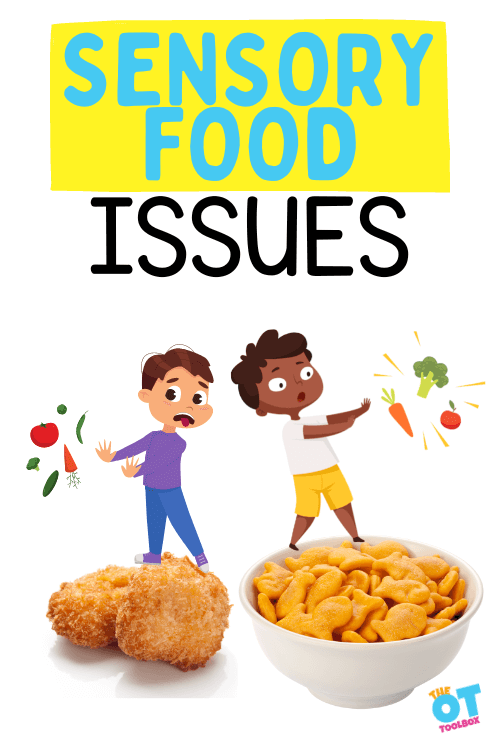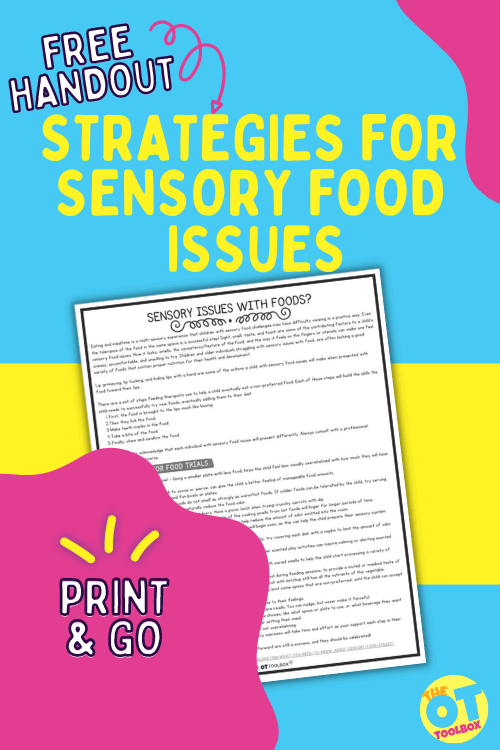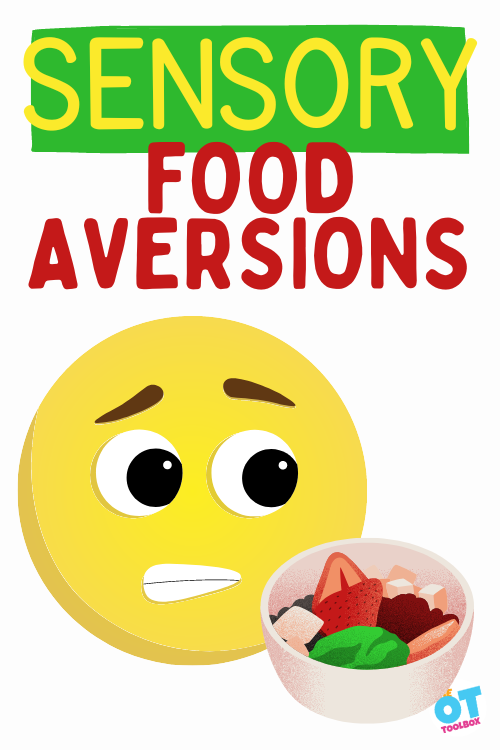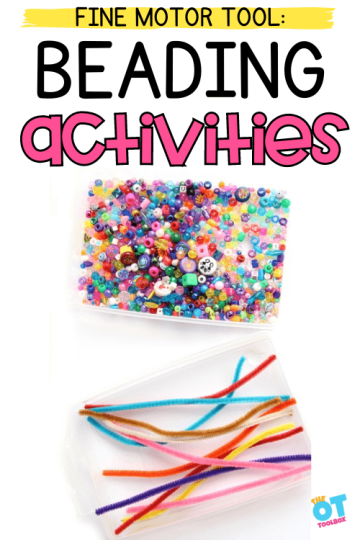Sight, smell, taste, and touch are some of the contributing factors to a child’s sensory food issues. How it looks, smells, the consistency/texture of the food, and the way it feels on the fingers or utensils can make a child/learner feel uneasy, uncomfortable, and unwilling to try. Children and older learners struggling with sensory issues with food, are often lacking a good variety of foods that contain proper nutrition for their health and development.
Sensory touch is a huge piece of this; not only the texture of foods in the mouth but the “feel” of foods as we handle them and chew them.

sensory food Issues
There is a range when it comes to determining sensory eating disorders. From extreme food aversion to the simplest of sensory food preferences. We all have probably experienced some aspect of this, at one time or another because everyone of us has different levels of sensory aversions.
Think about a food that you don’t prefer just because of the texture. Maybe it’s biting into a banana or a mushroom. Perhaps it’s chewing the stringiness of asparagus or celery. Does the sensory aspect of food textures like drinking smoothies or biting into a mushroom throw you off? There are many aspects of eating that are rooted in the senses.
We as OT practitioners know that a colorful plate of food is contains essential food groups and healthy eating choices to help a child blossom and thrive. Children and older learners who struggle with sensory food issues, often can not climb this hurdle for themselves without OT intervention. OT practitioners are experts in play-based therapy, and feeding therapy is no different. OT’s enjoy making eating fun while improving the sensory culprits that challenge a child’s success with feeding.
Oral Motor Vs. Sensory Food Aversions
As a side note, picky eating is not always a “sensory” issue. Sometimes there can be oral motor issues at play or other considerations.
We have a variety of resources on the website related to oral motor considerations as this can be a safety issue when it comes to oral motor development and “pushing” kids to try new foods. You’ll want to check out these oral motor resources if you are concerned or questioning a sensory aspect of feeding challenges or an oral motor issue:
- Pediatric Feeding: Is it sensory or oral motor? This blog post includes a printable handout. (Also available inside the Member’s Club under Educational Handouts)
- Feeding Developmental Milestones– This resource covers developmental progression which can play a role in sensory food issues at each stage.
- Executive Functioning skills and meals– This blog post covers other aspects of cognition and safety of meals- including impulsivity, processing speed, coordination, and choking hazards.
It’s important to always seek out professional advice when it comes to feeding challenges in kids.
sensory food exposure and feeding therapy
The hierarchy of sensory exposure during feeding therapy, provides a good introduction and follow-through of steps to sequentially build sensory exposure to foods. The ultimate goal is being successful interacting or eating the non-preferred food. Eating and mealtime is a multi-sensory experience that children with sensory food challenges may have difficulty viewing in a positive way. Even the tolerance of the food in the same space is a successful step!
Aside from clinical assessment, this Food Inventory Questionnaire can help the therapist, develop a proper treatment plan. It gathers important data about a child’s current preferences, so that likes and dislikes can be established, to begin food introduction and food chaining in feeding therapy.
Children use their sense of sight to look at their plate of food, surroundings, and those who are joining the mealtime experience
We’ve all looked at something and thought, ‘That is really gross…YUCK’! Children who have sensory food aversions are “grossed out” when they see some foods. Along with “yuck”, comes gagging, coughing, face squinching, head-turning, hands to mouth, plate pushing, and even covering the food to hide it.
In their state of fight or flight, learners will try anything to avoid looking at the food, let alone eating it. Read more about this aspect in our resource on the limbic system.
Sometimes children get overwhelmed when they look at a plate, especially if the plate is packed to the edges with food, if the food on the plate is touching, or they do not see anything they like. How can you help kids who struggle with a visual aversion to food?
Visual Tips and Tricks
One strategy to support sensory food needs is to use the power of the visual sense. This can be explained in more detail below. We’ll cover several areas:
- Food separation on the plate
- Fun foods and fun presentations
- Motivating snack mats or plates
Food Separation –
This is an easy strategy to implement by simply separating the food with a good distance between each food choice, so that food does not touch. A muffin tray is another excellent way to keep food from touching.
Another fun idea is to turn mealtime into a game, to provide a little distraction from the actual act of eating. Hopefully the activity will make eating a more positive experience, rather than a dreaded one.
Take a look at a few products available for this technique, that provide food separation by design:
(Amazon affiliate links below)
- Dinner Winner Food Game Tray is a food tray that is designed like a board game and the child travels the food sections to get to the end where a special treat awaits
- SpinMeal Plate is a plate where an arrow is in the center of the sectioned food plate. The child spins the arrow to choose the food compartment to try
- Divided Kids Dinner Plate is a colorful portioned plate that contains encouraging words to provide ongoing motivation
- Sectioned Dinnerware Plate is a game board where a child gains points with each section of food trialed or eaten
- Divided Lunch Trays are simple divided trays that are solid in color, making them less visually distracting for children who may become overwhelmed with all of the visual clutter of the other game trays and plates
Smaller Plate and Utensil – Using a smaller plate with less food, helps the child feel less visually overwhelmed with how much they will have to eat. Using a smaller spoon or fork to scoop or pierce, can give the child a better feeling of manageable food amounts. Read more about tips and strategies to help kids learn to hold a spoon and fork.
Fun Food
Make food look more fun and less ‘foodie,’ as you create images and scenes with the food, making it more enticing to trial. Who doesn’t want to eat rainbow snacks or how about Flower snacks? These treats are fun to look at, and motivating to eat.
Food Art Snack Mats – Try using fun snack mats you print and laminate. This can be used as a fun visual background while eating.
It’s easy to get the kids involved in making a variety of food art snack mats, and games to support mealtime with kids.
Children use their olfactory sense to smell the flavors of the food, both while it is cooking and on their plate
“Shuwee, that stinks!” Yep, we’ve all said it about something. The neighborhood skunk, the car exhaust in front of us, the litter box, and even the spices in the kitchen.
Children who have olfactory sensitivity smell food odor at a much higher level of intensity. They pinch their noses, turn their heads, try and leave the table, or vomit/gag in response to the smell.
Check out the strategies below to help desensitize a child to the food smell. Slowly introduce smells of varied scents from light to heavy, to build desensitization more easily.
Olfactory Tips and Tricks
Essential Oil Set-up – Set up the space for eating by using a calming scent of essential oil that is easily tolerated by the child in the eating area. Essential oils can calm anxiety related to eating, and desenstize the system to the food odors. Hopefully this will make a child more tolerant to the less preferred smells
Coffee Bean Support – Use a few coffee beans near meals, as the coffee scent can help neutralize the smell of some foods. If your learner has an aversion to coffee, you might need to try a different neutralizer
Cold vs. Hot – Naturally, cold foods do not smell as strongly as warm/hot foods. If colder foods can be tolerated by the child, try serving foods cooler, to reduce the food odor naturally.
Kitchen and Dining Modification –
Addressing environmental considerations can have a big impact. Try these strategies:
- Consider moving mealtime experiences outdoors.
- Remove the child from the kitchen/dining area as some of the cooking smells from hot foods will linger for longer periods of time, within these rooms.
- Open a window or patio door, or using a fan when cooking, to help reduce the amount of odor emitted into the room. This can lessen the aversion to smells.
Meal Prep Warning – Before cooking, warn the child that cooking will begin soon, as this can help the child prepare their sensory system mealtime, as they use some of their learned coping techniques.
Cover the Smells – If serving food on the tabletop for the entire family, try covering each dish with a napkin to limit the amount of odor from each of the served foods.
olfactory play
Scented play activities– Scented sensory bins, scented play dough, or other scented play activities can inspire calming or alerting scented play.
Smell Bottles or Sniffing Jars – Create some fun sensory sniffing jars with varied smells to help the child start processing a variety of smells. These jars are created by placing a variety of scented objects into small containers with holes in the lid of the jar. The smell will rise out, and the child can sniff at manageable distances. The larger the hole, the more the scent is dispersed. Some ideas include cinnamon, coffee, coconut, lemon, lavender, peppermint, etc. Create these smell jars to play with, by stacking and matching to the card images of the scents, or play a fun guessing game, by smelling and guessing what scent it is, then matching the jar to the card image.
Children use their sense of taste to determine if they like the flavor of a food
Lip grimacing, lip tucking, and hiding lips with a hand are some of the actions a child with sensory food issues will make when presented with food toward their lips.
There are a set of steps feeding therapists use to help a child eventually eat a non-preferred food.
- First, the food is brought to the lips much like kissing.
- Then they lick the food.
- Make teeth marks in the food.
- Take a bite of the food.
- Finally, chew and swallow the food.
These are not all of the steps needed to approach gustatory aversion to food, and it’s important to acknowledge that each individual with sensory food issues will present differently.
Each of these steps will build the skills the child needs to successfully try new foods, eventually adding them to their diet.
Importantly, being a cheerleader for your child with sensory food issues or struggles is important. Try these tips for supporting small successes:
- Be patient, and celebrate each step as a success.
- Give a high five, a hug, or a cheer.
- Focus on whatever motivates the child to keep trying!
Gustatory Tips and Tricks
Some of these tips may help with the gustatory, or sense of taste as a strategy and powerful component in supporting sensory eating needs:
Sauce and Condiment Support – Use sauces or condiments as a support tool during feeding sessions, to provide a muted or masked taste of a trial food, to build acceptance of the food within the child’s diet. Broccoli with ketchup still has all the nutrients of this vegetable.
Spice Limits – Think about the spices used when cooking food, and try to limit some spices that are non-preferred, until the child can accept small amounts, that can be increased over time.
Children use their sense of touch to understand their food
“That feels gross! It’s mushy, slippery, sticky, hard, bumpy, etc.” There are many ways that texture food aversions can develop in children. The way they imagine it feels, the way it actually feels, or the way it feels transporting to the mouth. The best way to approach textural aversions is to introduce textures in a less threatening way – by play!
Always remember when playing with food that the goal is not just to eat, but to interact and build positive associations with food, and become more comfortable with the various aspects of it including texture, shape, color, smell, etc. Let the journey begin with the hands and the eyes.
Tactile Tips and Tricks
Sensory bins – They are a classic OT tool.
- Make sensory bins use cooked foods too! Remember if the food is cold, the smell is less intense, or many times there is no odor at all. Try using cooked spaghetti, pasta, rice, or veggies, some crumbled-up toasted bread, bagels, or rice cakes as a sensory bin. Note: Always be cautious when using cooked foods, making it a habit to throw out after play, for safety.
- Another idea is to make sensory bins containing play items that look like the foods a child has an aversion to. Simulated cooked spaghetti could be a yarn bin, toasted bread could be a cut-up sponge bin, and whipped cream could be a shaving cream or cotton ball bin. In addition, use the typical food items like dry beans, dry rice, dry pasta, graham cracker crumbs, oats, and water, as sensory bins for exploration.
- Make the bins more appealing by tossing in some fun toys, burying them, use fun voices to talk for the toys, or use a Mr. Munchie Man ball to support fun playtime. Kids love to see Mr. Munchie Man try smelling, kissing, and eating some of the textured items in the bins.
- Model play, by getting your hands into the bin, getting dirty to show the children this is a fun activity.
- Another strategy is to give the child utensils to poke around in the texture bins if they are resistant to placing their hands inside. Eventually work toward using smaller utensils and tongs until they become more tolerant and willing to dig in with their fingers and hands.
- Messy eating is another strategy that can work, too.
Food Presentation Changes
Think about the different ways you can change the texture of foods that children dislike, or change the presentation of the food, by adding something or making it differently.
Some ideas include:
- Presenting toasted bread instead of soft bread
- Yogurt with granola instead of plain yogurt
- Roasted or fried potatoes instead of mashed potatoes
- Banana slices with granola instead of plain banana slices
- Sliced or chunked apple pieces instead of applesauce
- Shredded meat instead of whole
- Shredded cheese instead of sliced or chunked cheese
- Covering pancakes with apple butter instead of syrup
Food Art Snack Mats
Grab a few food art snack mats and turn food into playtime fun while exploring textures.
- Make a Face using fruit pieces on a laminated placemat
- Cut out circles to create a space for a plate, cup, and on a paper placemat. Then, add paper forks and spoons. Laminate to create a reusable placemat the kids can decorate.
Non-edible Sensory Recipes
Check out these fun sensory dough recipes, and have fun making something that children can play, with while exploring a variety of textures. These recipes are simple to follow, and make the perfect tactile experience, while also providing ownership of the end product, as they make it themselves.
The recipes include play dough, Oobleck slime, Flubber, kinetic sand, silly putty, and cloud dough. A variety of textures to explore and digital download includes learning activities related to each recipe too!
Tips for sensory food issues
A few quick last thoughts on making the journey to mealtime a success for each child. When sensory food issues and challenges arise, keep these things in mind:
- Always honor the child’s responses to food interactions and be sensitive to their feelings.
- Never force a child to participate in actual eating of food until they are ready. You can nudge, but never make it forceful.
- Give the child as much control as possible by letting them make some choices, like what spoon or plate to use, or what beverage they want to drink. Try allowing them to pick their placemat or table cloth for setting their meal.
- Give them choices that are sufficient enough for their needs, but not overwhelming.
- Understand and accept that helping a child overcome food sensory aversions will take time and effort as your support each step in their journey.
- Keep practicing, and keep working. Even the smallest of steps forward are still a success, and they should be celebrated!
This sensory food issues post is part of a feeding series. Be sure to check out the other posts available on this topic. The Sensory Lifestyle Handbook is a great resource to understanding sensory struggles.
The Sensory Lifestyle Handbook walks you through sensory processing information, each step of creating a meaningful and motivating sensory diet, that is guided by the individual’s personal interests and preferences.
The Sensory Lifestyle Handbook is not just about creating a sensory diet to meet sensory processing needs. This handbook is your key to creating an active and thriving lifestyle based on a deep understanding of sensory processing.

Sensory Food Aversion Handout
When sensory food aversion is a real struggle in a household, everyone in the home can be affected. Educating on how to support an individual with sensory food aversions is key.
We’ve created a free handout that does just that. This printable sensory food aversion handout covers the strategies addressed in this blog post as an educational resource. While it’s not intended as a replacement for therapy, the handout covers strategies and supports that can be used along with therapy services and individualized interventions.
Therapy professionals can use this handout as an educational tool to support the needs of families.
Print off this sensory food strategies handout and add the resource to your therapy toolbox.
- Enter your email address into the form below.
- Check your inbox for the email containing the printable.
- Print it off and go!
Or, OT Toolbox Member’s Club members can access this printable resource inside the Member’s Club. Log into your account and head to Educational Handouts. You’ll find the printable there.

Sensory Food Aversion
What is sensory food aversion, and how can we “fix” this? These questions will be answered in this upcoming post. There are many reasons learners are not able or willing to try new foods. There are many adults that only eat a handful of foods. This is not news. What is news, is that with the right treatment, and a willingness to change, food aversion is treatable. The keys are the right treatment, and a willingness to change.
What is sensory food aversion?
For billions of people, eating is enjoyable and comes naturally. For the rest, eating is a chore. One research study suggests 35% of Americans consider themselves picky eaters. In order to provide the “right treatment” it is first important to understand what is going on. To accurately diagnose a sensory food aversion, it is helpful to rule out what it isn’t.
food aversion causes
When it comes to Sensory food aversions to certain food textures or types of foods, it’s important to rule out medical issues.
As scary and difficult medical issues feel, apart from eating disorders, they are much easier to treat than sensory based food aversion. It is akin to prescribing glasses to the visually impaired, rather than enduring months of vision therapy.
- Reflux – this condition can cause pain or discomfort minutes or hours after eating. A person may associate this discomfort with a particular food, and avoid it later
- Vomiting – if you have ever vomited after eating a certain food, you understand this one. Even if it was not the food’s fault, the negative association with the last food consumed can last a long time
- Tonsillitis – enlarged tonsils can make it feel like the food is getting stuck in the throat, or cause pain/pressure as it passes
- Eating disorder – ARFID is the term being used for food avoidance. Avoidance Restrictive Food Intake Disorder is what is often diagnosed instead of picky eating. Anorexia and Bulimia are common eating disorders where the brain isn’t communicating well with the body. There are mixed messages being sent about body size, the effect of food on the body, or a projected self-image.
food aversion psychology
Take into account Social/Emotional Challenges when it comes to sensory food preferences and aversions.
While these social and emotional challenges are not easy to overcome, they are more straightforward to understand than sensory based eating challenges.
- Memories – while some people associate foods with great memories, others associate it with negative experiences. Perhaps this food memory is associated with a medical issue, a food that did not taste right, or a negative eating experience.
- Social – eating tends to be a very social event. Eating with friends, eating in front of others, or cooking/serving family and friends. Those with an eating disorder or social anxiety, do not like people to see them eat for a variety of reasons. They may not like watching others eat either.
- Feeling trapped – once that first bite is in the mouth, there is no going back. Taking an unknown bite often feels like jumping head first into an icy pool. The risk involved in taking just one bite may be too overwhelming. Better to stick with the safe crackers instead.
- Emotions – not being able to eat what others are enjoying can be embarrassing. It can provoke anxiety, mistrust, frustration, anger, disappointment, or shame. Are these feelings worse when a person avoids the food, or tries and does not like it?
- Risk avoidance – Is it better to play it safe, or jump into that icy water? Some people are born risk takers, ready to take a leap, while others prefer to take it slow and just dip one toe in first. Eating something unfamiliar feels risky.
It might be Sensory Sensitivity.
Sensory information is bits of data taken in by the sensory receptors. When the information comes in correctly, data is processed, leading to a satisfactory outcome. When the sensory receptors do not transmit accurate information, trouble ensues. To the avoider, input can be too noisy, sticky, wet, bumpy, dizzying, heavy, painful, itchy, and 100 other complaints. The seeker, on the other hand, can not get enough input. Things are not loud enough, rough, spicy, hot, cold, exciting, stimulating, sticky, or 100 other needs. The learner who is sensitive may experience the following when it comes to eating:
- Tactile sensitivity – the mouth has tons of sensory receptors. The sensory receptors send messages to the brain to process the information. For some, the messages come in LOUD. This food is too sticky, crumbly, soft, gritty, lumpy, dry, or slimy. Touch is not limited to the mouth. The feel of food on the hands can be overwhelming also.
- Taste sensitivity – there are many different types of taste buds. Young children have more taste buds than their adult counterparts. People lose taste buds as they age, possibly making foods more tolerable in adulthood. There are taste buds to register sour, spicy, and sweet. Those taste receptors may be sending messages that register as too sweet, sour, spicy, tangy, salty, bitter, spoiled, or just different.
- Olfactory (smell) sensitivity – Do you know someone who gags at certain smells? Like the other senses, the receptors in the nose are sending mixed messages. For a foodie, the smell of food cooking is wonderfully intoxicating. The avoider finds it toxic. Smells may trigger bad memories, signal the brain that it is time to eat, or set off alarm bells. There are some places where food smells seem worse, such as enclosed spaces, (airplanes, offices, cars) or overwhelming places (restaurants, grocery stores, the food court).
- Auditory – Yes, the sound of food can be a trigger. It could be the sound of food cooking, or worse, the sounds involved in eating food. Misophonia is a condition of auditory sensitivity that causes rage outbursts, often associated with the sound of people chewing.
- Visual – How the food appears can be a trigger for many. It might look “weird or gross” to a picky kid. Just the sight of some foods is enough to turn people off of eating. How easy would it be to eat something that resembled cat food to you? Watching other people eat is not easy. Some people have terrible eating habits. To someone sensitive, this can easily be another big trigger.
The seeker craves input, and can not get enough. Food can be similarly frustrating as it is to the avoider, as the seeker constantly needs something to feel satisfied.
- Tactile: may play with food, put their fingers in their mouth, eat non food objects, constantly crave food, like cooking with their hands
- Auditory: these folks love sounds. They like it LOUD. They also do not notice sounds around them. They are not bothered by their own chewing or gulping, or the noises of those around them
- Taste: they like it spicy! The hotter the better. They like cooking with different tastes and experimenting with foods. These learners like extremes when it comes to foods. Sour, spicy, hot, icy cold, bitter, mixed tastes, or unusual combinations
- Visual: the visual seeker loves to surround themselves with input. They are not bothered by bright lights, messes, or visual chaos. They gravitate toward food presentation, watching cooking shows, or simply shopping for food.
- Smell: seekers in the smell department love the odor of food cooking. Walking by a bakery is like heaven to them. They tend to smell everything. Often these smell seekers are unaware of smells around them because it does not register. They may not notice someone with lots of perfume, a burning smell, or a dirty diaper.
Treatment for sensory food aversion
The first stage of treatment is understanding what is going on.
- Help your learner vocalize what they are experiencing. This may feel like a new language for them, so it can take a lot of practice
- Teach your learner to explore with words, rather than emotions or behavior
- Ask questions. What does the food taste like? Is it bitter, sour, spicy, sweet? How does it make you feel? Are you anxious, frustrated, depressed, angry, or just apathetic about food? What does the food feel like in your mouth? How does it smell? Try to expand vocabulary beyond “yucky” or “gross”. What can you hear while we are eating? Try and ask questions to cover all of the senses
- Present different sensory strategies and input to help your learner understand what is happening and begin to adjust to sensory input.
- The book, (Amazon affiliate link) Seeing your Home and Community with Sensory Eyes, is set up in this format to help you understand the how and why these sensory challenges happen, and what to do about it
The next stage of treatment is balancing the sensory system
For the seeker, balance may look like adding more of the right input to satisfy the sensory systems. The avoider will need a dose of systematic desensitization to get the system used to receiving and cataloging sensory input.
- Systematic desensitization is a long fancy word for teaching your learner to slowly get used to something. The Sensory Oral Sequential SOS method of eating involves slowly desensitizing the brain/body to a new food. It starts with being in the same room as the food, and 27 steps later the food is swallowed.
- Making small changes to foods, having your learner engage with food, giving them control over food choices is a good start.
- Tactile – work in and around the hands and mouth. Provide safe choices for touching with the hands such as dry rice, dry beans, sand, play dough, birdseed, shaving cream, or slime. Start with dry textures, moving toward wet and sticky. “Safe choices” refers to something that is not threatening. Playing in birdseed is not threatening to your learner because they know they are not expected to eat it. When comfortable, you can move your learner to engaging with actual food such as whipped cream, pudding, fruits, or a bowl of dry cereal. Decrease tactile sensitivity in the mouth. Use a vibrating toothbrush, an icy washcloth, Twizzlers left out to harden overnight, sour spray, or popsicles to get the mouth used to different temperatures and textures.
- Auditory – practice listening to different types of sounds and music. There are videos of people eating and chewing to desensitize your learner. These are difficult to listen to, so wade in slowly. As an alternative, provide noise canceling headphones for a while to help your learner tune out sounds.
- Visual – check out videos of people eating, food preparation, presentation of foods, cooking channel, kids cooking shows. The idea is to desensitize the learner to reduce triggers.
- Olfactory – work on smell aversion by providing more smells to balance the sensory system in the nose. These can start out pleasant like lemon or peppermint. Open the spice cabinet for sniffing. See if your learner can identify items by their smell. Coffee beans are great to have around as they cancel out smells in the nasal passageways. Once someone is triggered, have them smell the beans to reset their system.
- Taste – practice tasting and identifying. Make a conscious effort to teach your learner to describe the food. Try very different tastes. Some people love spicy foods, others can’t get enough of sour (try Warheads sour spray, or lemon juice). Different dipping sauces can help. Ketchup seems to help immensely. Other dippers could be honey, ranch dressing, mustard, sugar, salt, peanut butter, butter, barbeque sauce, honey mustard, etc. Many picky eaters do not like spices or anything extra at all. Be mindful of this. If this is the case, serve very plain foods for a while. Mixed textures are more difficult to tolerate as they have several different tastes in one. The temperature of food can have different effects. Some picky eaters like everything at room temperature. Not too hot or cold for these folks.
Other strategies to treat sensory food aversion:
- Keep a food log of what foods are consumed, how they are tolerated, and the response to input. The food log may show similarities and patterns.
- Try and work through unusual eating habits such as no food touching, eating all of one food before the others, needing a certain cup/plate/bowl, not being able to pick up finger foods, or refusing to go places that serve food. While these are not life threatening, they are noticeable and can be changed to be more socially acceptable.
- Have one meal a day reserved for feeding therapy. The other two meals can be as the learner likes it. This alleviates some pressure for the learner and their family.
- Put foods on the plate and announce they are just there for show. You don’t expect them to be eaten. Sometimes taking the pressure off of trying allows learners the freedom to try
- Serve small portions so that sensory receptors are not overwhelmed with too much visual, auditory, or olfactory input.
- If your learner is sensitive in many sensory categories, it might be wise to limit stimuli in one or more areas while working on another. Some examples would include; noise canceling headphones, having your learner eat without an audience, limiting overwhelming smells, providing utensils and non finger foods.
- Take a food vacation sometimes. Once in a while it is ok to just leave this condition at home. Pack a sandwich if you are going somewhere that offers no favored foods. Let your kid survive on bread rolls for a week on vacation. This is hard to do, but worth it in the long run. Just don’t make it part of the norm to avoid food tasting.
For the non “foodie” this condition is exhausting. It feels like mealtime comes around 18 times a day. One meal is finished, and it is time to start working on the next. Enjoyable events like birthday parties and family gatherings evoke anxiety because of the food being served, rather than feelings of happiness. Start by understanding what is happening, talking about it, then finding the right treatment for the learner with sensory food aversion.

Regina Parsons-Allen is a school-based certified occupational therapy assistant. She has a pediatrics practice area of emphasis from the NBCOT. She graduated from the OTA program at Caldwell Community College and Technical Institute in Hudson, North Carolina with an A.A.S degree in occupational therapy assistant. She has been practicing occupational therapy in the same school district for 20 years. She loves her children, husband, OT, working with children and teaching Sunday school. She is passionate about engaging, empowering, and enabling children to reach their maximum potential in ALL of their occupations as well assuring them that God loves them!
Note: while this post refers to children, people of all ages and stages suffer from sensory food issues. Many of this information pertains to any age, and can be used for different age groups.







